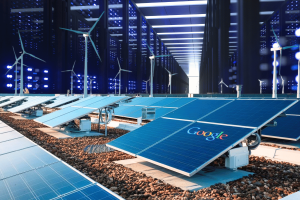Google invests in renewable energy in a bid to power AI data centers sustainably

Google has unveiled plans to collaborate with partners to develop gigawatts of renewable energy, battery storage, and grid upgrades to support its AI data centers. On Tuesday (Dec. 10), the tech giant announced a strategic partnership with Intersect Power and TPG Rise Climate to “synchronize new clean power generation with data center growth in a novel way,” using carbon-free power.
As reported by TechCrunch, the initiative involves a $20 billion investment in renewable energy projects, with Intersect Power already financing the first development. The agreement also includes an $800 million equity investment in Intersect Power, led by TPG, with participation from CAI, Google, and Greenbelt Capital Partners.
TPG’s executive chairman Jim Coulter said: “The convergence of two megatrends — decarbonization and digitization — is creating unique opportunities for innovative partnerships.”
Intersect Power CEO Sheldon Kimber added: “We can and are developing innovative solutions to rapidly expand clean power capacity at scale while reducing the strain on the grid.”
How much energy will AI data centers use?Research from Gartner suggests that by 2027, 40% of existing AI data centers could face operational challenges due to power limitations, causing tech firms to secure alternative energy sources. While the International Data Corporation (IDC) predicts that AI data center energy use will grow by 44.7% annually, reaching 146.2 Terawatt hours (TWh) by 2027, as AI workloads take up an increasing share of total data center electricity.
Previously, ReadWrite reported that in October, Google signed the world’s first corporate agreement to purchase nuclear energy from small modular reactors. Just last week, Meta expressed similar intentions.
The Google deal to acquire small nuclear reactors to power data centers increases the odds that we will see AI models scale through at least 3 more generations/orders of magnitude (post GPT-5) to 2030.
According to Epoch, power was the binding constraint. https://t.co/FQtUsE0L9d pic.twitter.com/lChspwoZjC
— Ethan Mollick (@emollick) October 15, 2024
In addition, Morgan Stanley’s recent findings estimate that data centers could generate 2.5 billion tonnes of greenhouse gas emissions globally by 2030, a figure that could be three times lower without the rise of generative AI. Consequently, the rapid expansion of generative AI has placed significant strain on the U.S. power grid.
However, Amanda Peterson Corio, Google’s global head of data center energy, told Bloomberg that the company is committed to covering 100% of the costs required for grid upgrades associated with these projects because of AI data centers’ increased energy usage.
The initial phase of the first co-located clean energy project is slated to begin operations in 2026, with full completion expected by 2027.
Featured image: Ideogram
The post Google invests in renewable energy in a bid to power AI data centers sustainably appeared first on ReadWrite.
